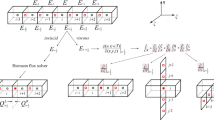Abstract
Developing high resolution finite difference scheme and enabling the use of this scheme on complex geometry are the aims of this study. High resolution has been achieved by Dissipative Compact Schemes (DCS), however, according to the recent research, applications of DCS on complex geometry may have serious problem for that the Geometric Conservation Law (GCL) is not satisfied, and this may cause numerical instability. To cope with this problem, a new scheme named Hybrid cell-edge and cell-node Dissipative Compact Scheme (HDCS) has been formulated. The formulation of the HDCS contains two steps. First, a new central compact scheme is formulated for the purpose of conveniently fulfilling the GCL, and then dissipation is added on the central scheme by high-order dissipative interpolation of cell-edge variables. The solutions of Euler and Navier-Stokes equations show that the HDCS can be applied successfully on complex geometry, while the DCS may suffer numerical instabilities. Moreover, high resolution of the HDCS may be observed in the test of scattering of acoustic waves by multiple cylinders.
Similar content being viewed by others
References
Tim C, Lele S K. Computational aeroacoustics: progress on nonlinear problems of sound generation. Prog Aerosp Sci, 2004, 40: 345–416
Ghosal S. An analysis of numerical errors in large-eddy simulations of turbulence. J Comput Phys, 1996, 125:187–206
Lele S K. Compact finite difference schemes with spectral-like resolution. J Comput Phys, 1992, 103: 16–42
Rizzetta D, Visbal M, Morgan P. A high-order compact finite-dierence scheme for large-eddy simulation of active flow control. Prog Aerosp Sci, 2008, 44: 397–426
Fu D X, Ma Y W. A high-order accurate difference schemes for complex flow fields. J Comput Phys, 1997, 134: 1–15
Deng X G, Maekawa H, Shen Q. A class of high-order dissipative compact schemes. AIAA paper 96-1972, 1996
Deng X G, Zhang H X. Developing high-order weighted compact nonlinear schemes. J Comput Phys, 2000, 165: 22–44
Deng X G, Maekawa H. Compact high-order accurate nonlinear schemes. J Comput Phys, 1997, 130: 77–91
Harten A, Engquist B, Osher S, et al. Uniformly high-order essentially non-oscillatory schemes, III. J Comput Phys, 1987, 71: 231–303
Jiang G, Shu C W. Efficient implementation of weighted ENO. J Comput Phys, 1996, 181: 202–228
Wang Z J. High-order methods for the Euler and Navier-Stokes equations on unstructured grids. Prog Aerosp Sci, 2007, 43: 1–41
Deng X G, Mao M L, Tu G H, et al. Geometric conservation law and applications to high-order finite difference schemes with stationary grids. J Comput Phys, 2011, 230: 1100–1115
Deng X G, Min Y B, Mao M L, et al. Further studies on geometric conservation law and applications to high-order finite difference schemes with stationary grids. J Comput Phys, 2013, 239: 90–111
Deng X G, Mao M L, Jiang Y, et al. New high-order hybrid cell-edge and cell-node weighted compact nonlinear schemes. AIAA paper 2011-3857, 2011
Thomas L G, Xavier G, Christophe C. Multi-size-mesh, multi-time-step algorithm for noise computation around an airfoil in curvilinear meshes. AIAA 2007-3504, 2007
Bodony D J. Analysis of sponge zones for computational fluid mechanics. J Comput Phys, 2006, 212: 681–702
Deng X G, Mao M L, Tu G H, et al. Extending weighted compact nonlinear schemes to complex grids with characteristic-based interface conditions. AIAA J, 2010, 48: 2840–2851
Verhaagen N G, Elsayed M. Leading-edge radius effects on 50° delta wing flow. AIAA paper 2 2009-540, 2009
Jameson A. Time dependent calculations using multigrid with applications to unsteady flows past airfoils and wings. AIAA Paper 91-1596, 1991
Jiang Y, Deng X G, Mao M L, et al. Large eddy simulation based on seventh-order dissipative compact scheme. The Ninth Asian Computational Fluid Dynamics Conference, Nanjing, China, 2012
Author information
Authors and Affiliations
Corresponding author
Rights and permissions
About this article
Cite this article
Deng, X., Jiang, Y., Mao, M. et al. Developing Hybrid cell-edge and cell-node Dissipative Compact Scheme for Complex Geometry Flows. Sci. China Technol. Sci. 56, 2361–2369 (2013). https://doi.org/10.1007/s11431-013-5339-6
Received:
Accepted:
Published:
Issue Date:
DOI: https://doi.org/10.1007/s11431-013-5339-6




